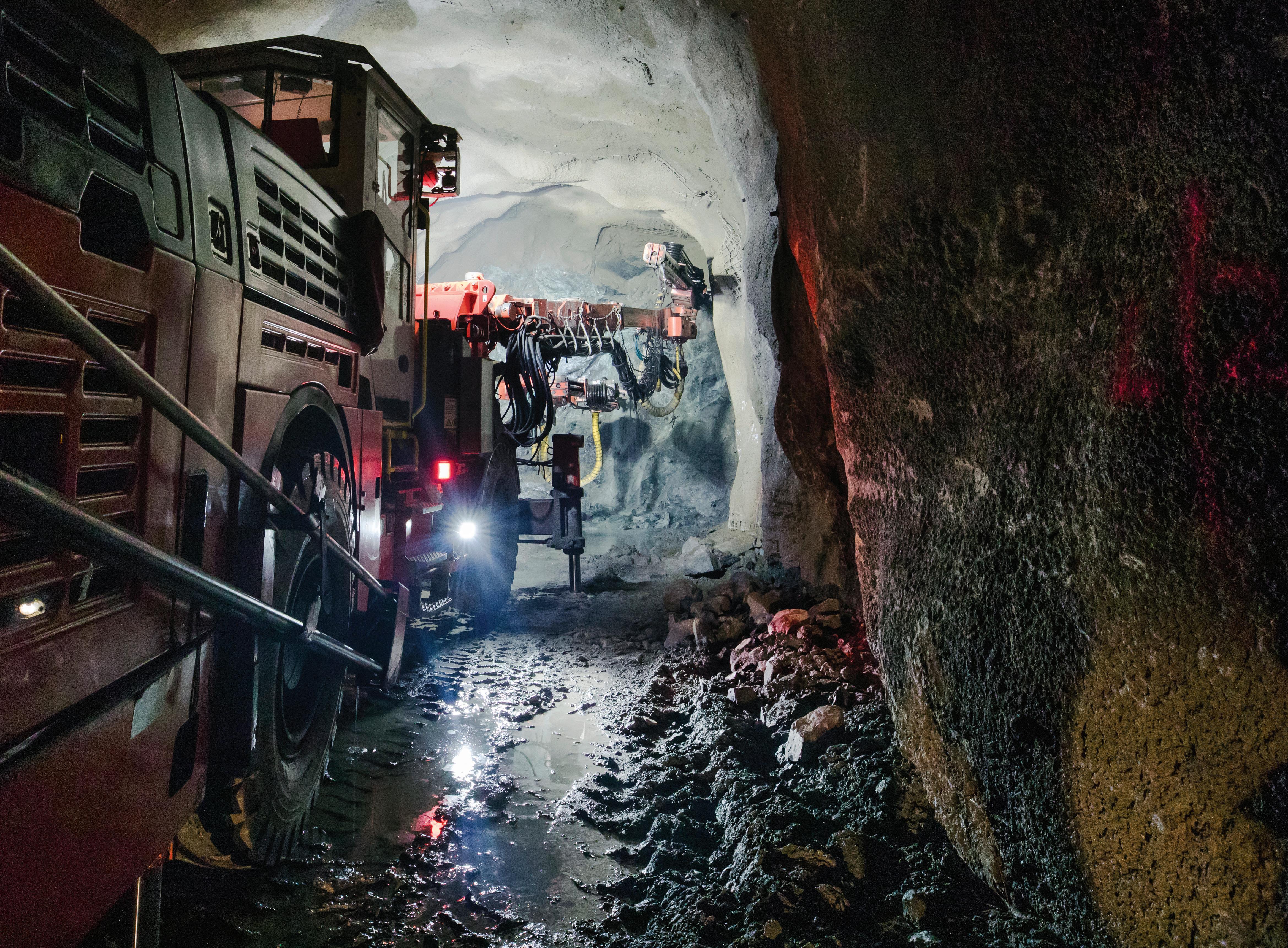
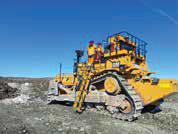
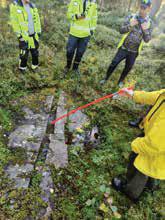
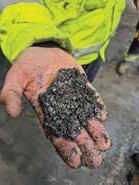



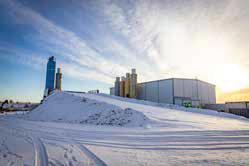


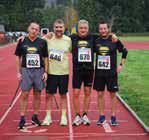



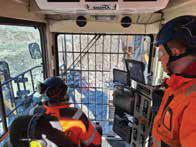




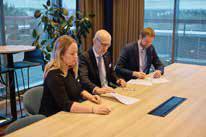




























This is the first standalone sustainability report by Tapojärvi, covering data for the 2024 reporting year.
The report is voluntary and follows the structure of the European Sustainability Reporting Standards (ESRS).


Sustainable development is a fundamental pillar of Tapojärvi’s operations. While Tapojärvi operates at the core of industry, our thinking extends beyond — to the environment and society as a whole. We utilize industrial side streams, develop circular economy products, and invest in a safe, skilled, and wellbeing-oriented work community.
This is Tapojärvi’s first standalone sustainability report, and covering data from the reporting year 2024. The report is voluntary and follows the structure of the european sustainability reporting standards (ESRS).
The purpose of this report is to strengthen our preparedness to meet the reporting requirements of the corporate sustainability reporting directive (CSRD) and to provide a clear, comparable, and well-substantiated overview of Tapojärvi’s sustainability-related impacts, risks, opportunities, and actions.
The scope of the report aligns with tapojärvi’s consolidated financial statements and covers the group’s operations in finland, sweden, italy, and greece. Consequently, Tapojärvi’s subsidiaries do not publish separate sustainability reports. In addition to our own operations, this report includes information from both the upstream and downstream ends of our value chain. As part of the double materiality assessment, impacts, risks, and opportunities have also been evaluated in relation to the value chain.
In line with the esrs, sustainability aspects are considered across three time horizons:
• Short-term: current and following year
• Medium-term: up to five years
• Long-term: beyond five years
Where available, quantitative indicators are presented for both 2024 and the preceding year.
Tapojärvi operates as a subcontractor in the mining and steel industries, typically on sites managed by the client. In these environments, many responsibilities are held by the client, including environmental permitting, site infrastructure (e.G., Electricity and water supply), waste management, regulatory reporting, and stakeholder communication. This division of responsibilities affects Tapojärvi’s assessment of the materiality of various sustainability themes, as well as the availability and consistency of the related data. Any such limitations are described in more detail under the respective sustainability topics throughout the report.
Tapojärvi is a Finnish family-owned limited liability company, operating under the laws of Finland. The Tapojärvi Group consists of the parent company Tapojärvi Oy and its subsidiaries Tapojärvi Sverige AB, Tapojarvi Italia S.r.l and Tapojarvi Hellas M.I.K.E.
Tapojärvi Oy’s governing bodies include the General Meeting of Shareholders, the Board of Directors, the Acting CEO, and the Management Team. In 2024, the Board of Directors consisted of four members, two of whom were independent. All board members were male. The Management Team comprised 12 members responsible for the company’s business areas and support functions, including two women. At present, employee representatives are not included in these governance bodies.
The Board of Directors is responsible for approving the Group’s strategy and long-term objectives, and for overseeing their implementation. It also participates in the assessment and supervision of key risks and opportunities, in cooperation with the investment, finance, and accounting teams. The Management Team is responsible for leading and developing the Group’s operations in accordance with the strategy and objectives defined by the Board.
The Board annually approves and reviews Tapojärvi’s sustainability commitment and direction. The Management Team approves sustainability principles, roadmaps, and targets. The sustainability team is responsible for implementing the roadmaps, as well as guiding and consulting business area and support function leaders in the execution of sustainability actions.
At Tapojärvi, performance incentives linked to sustainability targets are tied to proactive safety work, the fulfilment of occupational safety responsibilities, and the reduction of accident frequency. These sustainability-related goals account for 40% of the management’s performance-based bonus scheme. Employees are also eligible for a separate monthly safety bonus.
Tapojärvi’s strategy is built around long-term objectives aimed at achieving profitable growth, strengthening competitiveness, and advancing sustainable development—both domestically and internationally. The company’s operations are grounded in deep expertise in mining services and industrial circular economy solutions, which are systematically expanded into new markets. Tapojärvi strives to be the preferred service partner for its customers by combining environmental awareness, technological know-how, and operational efficiency.
• Safety and employee well-being: Tapojärvi recognizes that a safe and healthy workforce is the foundation of long-term success. The strategy includes a strong commitment to improving occupational safety and to engaging and training employees at all levels.
• International growth: the company actively seeks opportunities to expand in the mining and circular economy sectors. Internationalisation is pursued deliberately, in alignment with the company’s values and core competencies.
• Technology and digitalisation: the use of modern technologies, automation, and digital tools is a key element of tapojärvi’s competitive advantage. The strategy guides investments in machinery in accordance with the best available techniques (bat) principle, and data is actively leveraged to optimise operational performance.
• Innovation and r&d: Tapojärvi allocates 2–4% of its annual revenue to research and development projects. The strategy emphasises the development of technologies and products that support circularity, aiming to reduce environmental impact while simultaneously growing the business.
• Long-term partnerships: the company invests in building and maintaining customer relationships based on trust and co-creation. Such partnerships foster a predictable operating environment and enable the continuous improvement of services and processes for mutual benefit.
Tapojärvi’s business model is built on three interrelated core areas: mining services, industrial circular economy, and TapoEko circular economy products. These areas are united by a strong customer-oriented approach, modern technology, resource efficiency, and continuous development.
Tapojärvi provides comprehensive services to mining companies at both underground mines and open-pit sites. The services cover nearly all phases between drilling and ore crushing, as well as a variety of production support services.
The industrial circular economy business focuses on processing industrial side streams—particularly slag—into new recycled products. Services include slag cooling, screening, beneficiation, and productisation.
A common feature across all business areas is a solution- and customer-driven approach: services are carefully tailored to meet each client’s specific needs, with the goal of enhancing the customer’s own efficiency, sustainability, and competitiveness.
Tapojärvi’s in-house machinery fleet, maintenance organisation, laboratories, and mixing plant support this business model by providing the required self-sufficiency and ability to respond rapidly to operational needs.
The company’s business model is designed to support growth, efficiency, and responsibility—combining stable cash flow from mining services, growth drivers from industrial circular economy, and future potential through TapoEko products.
This multi-layered structure strengthens Tapojärvi’s resilience and enables agile responses to changes in the market and regulatory environment.



Services for the Mining Industry
Ore and Waste Rock Drilling
Loading and Hauling
Services for the Steel Industry
Transport of Molten Slag
Slag Cooling and Processing
Recovery and Reuse of Metals

Other Mine Production Tasks Crushing

Slag Beneficiation and Metal Recovery Utilisation of Industrial Side Streams
Circular Economy Services for Various Industrial Sectors

TAPOEKO Recycled Products and Services
MINING, FORESTRY, CONSTRUCTION and ELECTRONICS INDUSTRY

Tapojärvi’s double materiality assessment was based on a data- and science-driven methodology developed by upright oy. As input data, tapojärvi provided information on its products and services, suppliers, human resources, and the geographical distribution of all these elements, along with other indicators potentially influencing materiality.
In the second phase of the process, the data model analysed the materiality of each sustainability topic using extensive third-party databases and a corpus of over 250 million scientific articles. The assessment considered the scale, severity, irremediability, and likelihood of potential impacts.
No separate stakeholder surveys were conducted to complement the assessment. Instead, tapojärvi made use of previously collected survey data from employees and customers. Finally, the results of the scientific analysis were compared with the survey findings, and the final materiality decisions were made by tapojärvi’s sustainability team.
Based on the double materiality assessment, tapojärvi’s most significant impacts on the environment and society, as well as key sustai-
nability-related risks and opportunities, are linked to the following topics:
• climate change
• pollution
• water resources
• resource use
• circular economy
• own workforce
• business conduct
Material impacts were also identified in relation to biodiversity and ecosystems, workers in the value chain, and affected communities. However, these topics were excluded from the scope of this report in accordance with applicable transitional provisions and voluntary disclosure allowances.
A summary table of the identified key impacts, risks and opportunities is presented on the following page.
Sustainability — particularly occupational and environmental safety — is integrated into the core of tapojärvi’s operations, strategy, and business model.
In line with our operational policy, we are committed to providing a safe working environment and minimising the negative environmental impacts of our activities. Our goal is zero harm.


Safety is the first and foremost of tapojärvi’s core values, underscoring its strategic and day-to-day importance in all our operations. Safety is built through small, everyday actions and decisions, and success in this area enables us to operate in the value chains of the mining and steel industries, where inherent risks are significantly higher than in many other sectors.
Every failure in safety—or in preventing work-related illnesses—is deeply impactful on an individual level, and also leads to both direct and indirect costs for the business.
Tapojärvi’s operations are grounded in full compliance with all applicable laws, regulations, and permit requirements. As a specialist in mining services and materials handling, we recognise the environmental impacts of our operations and are fully committed to sustainable practices across all areas of activity. We aim to lead the development of the industrial circular economy. Our circular solutions help reduce the use of virgin raw materials and lower the carbon footprint of the value chain. Sustainability is viewed not only as a competitive advantage, but as a prerequisite for longterm business continuity.
Environmental regulation, technological advancements, and market shifts have a direct impact on our business. Tapojärvi actively participates in product and technology development projects and seeks to utilise available funding instruments for these initiatives. We make long-term investments in hybrid equip-
ment, digital solutions, and side-stream processing, while prioritising operational efficiency and the added value generated through sustainability. Our sustainability efforts support our customers’ climate and responsibility goals. Alongside fossil fuels, we offer the option to use renewable fuels and alternative energy sources.
As our operations continue to expand and internationalise, tapojärvi’s strategy and business model must place increasing emphasis on good governance, compliance across different operational areas and countries, and the implementation of anti-corruption measures. These efforts are essential to minimise reputational and financial risks.

Impact/Risk/Opportunity Description Source
Positive impact Tapojärvi’s circular economy services reduce the need for virgin raw materials, thereby lowering energy demand and emissions in their production value chains.
Negative impact Tapojärvi’s beneficiation plants and mobile equipment, as well as the value chains of the mining and steel industries, consume significant amounts of energy and generate substantial greenhouse gas emissions.
Opportunity
Lower risk premiums and access to green financing for companies mitigating climate change. Revenue potential as customer demand shifts toward resource-efficient and low-emission solutions.
Risk The transition to a low-carbon economy may present risks if employees, authorities, investors or customers react negatively to insufficient climate action or operations in high-emission sectors.
Own operations
Own operations; upstream and downstream value chain
Own operations
Own operations; upstream and downstream value chain
Impact/Risk/Opportunity Description Source
Positive impact Circular economy services reduce the need for virgin materials and energy, thereby lowering emissions and other pollution resulting from their production.
Negative impact Tapojärvi’s operations may cause harmful air and particle emissions. In the event of leaks or insufficient water treatment, industrial chemicals and heavy metals may enter water or soil.
Risk New legislation and tightening environmental standards may increase costs due to required investments or higher financing costs.
Own operations; upstream and downstream value chain
Own operations
Own operations; upstream and downstream value chain
Impact/Risk/Opportunity Description Source
Negative impact Tapojärvi’s own operations and the value chains of the mining and steel industries use significant volumes of water in water-risk areas. Waste, process, and industrial water may lead to emissions and burdens on water bodies.
Risk Dependence on freshwater creates a risk of limited availability and rising costs. Stricter water discharge limits may increase capital costs.
Own operations; upstream and downstream value chain
Own operations; upstream and downstream value chain
Impact/Risk/Opportunity Description
Positive impact Tapojärvi’s circular economy services enable the reuse of slag, recovered metals and other materials in accordance with circular economy principles.
Negative impact Materials destined for final disposal and hazardous waste generated in operations may cause negative environmental and health impacts if not properly or adequately handled.
Opportunity Circular solutions allow for the utilisation of industrial side streams in product manufacturing and material reuse, while also improving raw material selection toward more sustainable alternatives.
Risk Dependency on fossil fuels and other raw materials poses risks of resource scarcity. Regulations concerning resource use, waste, and side-stream management may increase costs.
Impact/Risk/Opportunity Description
Negative impact Tapojärvi’s operations and its linkage to the mining and steel industries expose the workforce to higher risks of occupational accidents and diseases. The male-dominated nature of these sectors may also amplify challenges related to gender equality, pay gaps, and workplace harassment.
Risk Regulations and reporting obligations related to the promotion of employee health, safety, equality, and equal pay may increase operational costs.
Impact/Risk/Opportunity Description
Negative impact While no misconduct has been identified, insufficient anti-corruption practices may expose the company to corruption and bribery risks, which are widely recognised as elevated in the mining sector.
Risk Authorities may require updated reporting procedures and the implementation of additional anti-corruption and anti-bribery measures through new legislation, potentially increasing operating costs.
Source
Own operations; upstream and downstream value chain
Own operations; upstream and downstream value chain
Own operations
Own operations; upstream and downstream value chain
Source
Own operations; upstream and downstream value chain
Own operations
Source
Own operations; upstream and downstream value chain
Own operations

Tapojärvi reduces environmental impact by utilising industrial side streams, developing low-carbon products, and investing in electric equipment and renewable energy.

Tapojärvi is committed to promoting energy efficiency in line with technological progress as outlined in its environmental policy. The company actively pursues energy-efficient solutions and collaborates with customers and other partners to integrate the latest technologies and cleaner fuel alternatives wherever possible, in order to reduce its carbon footprint.
Tapojärvi’s business operations are based on multi-year contract agreements, which require investment in machinery and equipment tailored to the defined scope of services. These investments are made through comprehensive techno-economic evaluations that follow the best available techniques (bat) principle. As a result, most of tapojärvi’s new equipment represents the highest available environmental and energy performance standards.
To support climate change mitigation, tapojärvi has invested in slag treatment technologies and the development of circular economy products. The tapoeko product family is expected to grow into a third business pillar alongside mining services and industrial circular economy operations.
Through our investments in industrial circular economy and product development, tapojärvi aims to contribute to climate change mitigation by generating a positive handprint effect.
Tapojärvi has not yet developed a formal transition plan for climate change mitigation or a specific action plan for reducing energy consumption and emissions. However, progress is made through practical measures that align with our environmental policy.
The most significant climate-related impacts of tapojärvi’s operations result from fuel use (mobile equipment) and electricity consumption (beneficiation plants). Decarbonisation efforts primarily relate to the choice of fuels, the origin of electricity, and decisions regarding the shift toward low-emission energy sources.
At most sites, fuels and electricity are procured either directly from suppliers selected by the customer or via the customer, meaning energy-related decisions are made jointly. In 2024, tapojärvi transitioned to biofuels at its kemi mine and tornio site, and solar panels installed at the keminmaa central maintenance facility began generating renewable electricity.
While energy choices have the greatest influence on emissions, technology decisions also play a role. Environmental aspects are considered as part of the techno-economic assessment of new machinery purchases.
Technology choices are sometimes made in collaboration with customers and always with the operational environment in mind, especially site-specific infrastructure and constraints.
Tapojärvi actively monitors the development of electric vehicle technologies and battery innovations. We work closely with leading equipment manufacturers and are actively involved in piloting and adopting the latest technologies. In 2024, tapojärvi commissioned europe’s first hybrid loading machines.
Other practical decarbonisation measures include optimising driving behaviour, minimising idling, and improving energy efficiency at beneficiation plants and facilities.
Tapojärvi has not yet set specific targets for achieving carbon neutrality or improving energy efficiency. However, we closely monitor both energy consumption and greenhouse gas emissions, and we aim to achieve progress in terms of intensity-based performance indicators.
Tapojärvi operates in energy-intensive industries, and energy derived from fossil sources constitutes the majority of total energy consumption, primarily through the use of liquid fuels. The table below presents Tapojärvi’s energy consumption broken down by energy source.
Fuels from coal and coal products
Fuel
Fuels
The calculation is based on a number of assumptions. Most of the electricity used is not sourced directly from energy producers but is instead supplied via customer companies. As no energy source breakdown has been available for this intermediary electricity, the calculation has been based on country-specific residual mixes. For district heating, the calculation has been performed using supplier-specific production mixes.
In 2024, Tapojärvi’s Scope 1 emissions amounted to 63,050 tonnes of CO2equivalent (66 %), Scope 2 market-based emissions to 9,480 tonnes CO2equivalent (10%), and Scope 3 emissions to 22,464 tonnes CO2equivalent (24 %).
The total greenhouse gas emissions for Tapojärvi in 2024 were 94,994 tonnes of CO2equivalent.
In 2024, biogenic emissions from the use of biofuels totalled 4,680 tonnes of CO2equivalent. Emission factors from the UK Department for Environment, Food & Rural Affairs (Defra) were used in the calculation.
Tapojärvi monitors greenhouse gas emissions relative to revenue. The intensity is expressed as tonnes of CO2equivalentper million euros of revenue.
Greenhouse gas emissions have been calculated and reported in accordance with the GHG Protocol.
The 2023 calculation was third-party verified, and the 2024 calculation was conducted using the same principles and methods.
Scope 1 includes direct emissions from Tapojärvi’s own vehicles (liquid fuels, refrigerants) and facilities (cutting and welding gases, emissions from the use of explosives during detonation).
Emissions were calculated based on fuel and material consumption. Defra emission factors were used for fuels. Explosives-related emissions were calculated using emission factors provided by suppliers. Gas emissions were calculated based on carbon content. There are no material limitations in the Scope 1 emission calculations.
Scope 2 includes purchased electricity and heat used at Tapojärvi’s own premises. Supplier-specific emission factors were applied to electricity and heat consumption data.
Approximately 95 % of the electricity used is supplied via customer organisations. In these cases, customer-provided emission factors were applied.
Electricity consumption of mining equipment is not invoiced or reported, as available metering does not accurately distinguish users or devices. There are no other material limitations related to Scope 2 emission calculations.
The following material Scope 3 categories have been included, based on the availability of sufficiently reliable data:
#1 Purchased goods and services (e.g. water, production and process chemicals, tyres, explosives, other materials), #3 Fuel- and energy-related activities (e.g. energy production emissions, transmission and distribution losses), #5 Waste and wastewater; #6 Business travel (air travel); #7 Employee commuting (based on mileage and travel reimbursements)
Emission factors used in Scope 3 calculations were obtained from Suppliers, Authorities, Trusted emission factor databases, The largest assumptions were required for chemicals and waste emissions. In total, 96 % of data used was measured, and 4 % estimated.
Two additional material Scope 3 categories were identified:
#2 Capital goods
#4 Upstream transportation and distribution
However, these were excluded due to insufficient consumption data and a lack of reliable emission factors.
As a service provider, Tapojärvi’s Scope 3 emissions are largely upstream, and downstream emissions (categories #9–#15) are considered non-material.

Tapojärvi’s operational policy emphasizes delivering services and products that meet customer needs, with the aim of achieving customer satisfaction as well as sustainable and profitable business operations.
Our environmental policy reflects a commitment to excellence in environmental protection. In line with this policy, we reduce our environmental impact by preventing contamination and emissions into soil, air, and water. We aim to avoid the use of substances of concern and, where feasible, gradually phase out substances of very high concern.
Tapojärvi seeks to prevent environmental deviations through proactive, risk-based environmental management. In the event of a deviation, immediate measures are taken to mitigate potential environmental impacts. If soil or water is contaminated, tapojärvi takes action to remedy the adverse effects and restore the environment as close as possible to its pre-incident condition.
Tapojärvi continuously implements defined preventive measures to avoid environmental contamination. These include regular inspections of machinery and equipment, scheduled preventive maintenance, the acquisition of spill response equipment, and personnel training in managing exceptional situations.
Site-specific guidelines are in place for responding to deviations, such as procedures for handling fluid leaks and controlled shutdowns of enrichment facilities under specific wind conditions.
Tapojärvi monitors discharges to water from its own production facilities. Wastewater is treated either in customer-owned or municipal treatment
plants before being released into the environment. In mineral processing operations, we maintain and develop closed-loop systems that minimize water consumption and ensure the safe and efficient reuse of process water. Additional process measures are in place to prevent pollution, ensuring the preservation of water bodies for future generations.
Emissions to soil typically arise from oil leaks and are monitored based on environmental deviation notifications. Other emissions are measured and analyzed in accordance with monitoring programs defined in environmental permits—either those of our customers or our own.
Chemicals classified as substances of concern fall into specific hazard classes as defined by the reach and clp regulations (classification, labelling and packaging, eu regulation 1272/2008).
We regularly assess the chemicals we use to identify substances of concern, ensure proper classification, and label them in accordance with clp requirements. We also invest in the development of safer alternatives and processes and report to the authorities in compliance with reach registration and clp labelling obligations.
In accordance with our operational policy, we aim to minimize the negative environmental impacts of our operations. Our objective is zero harm.
All tapojärvi sites identify significant emission sources and monitor and control related emissions and pollutants, including their trends over time. The monitored substances vary based on site size and activity. The purpose is to ensure that emissions remain within the limits set by applicable legislation, contracts, and both tapojärvi’s and its customers’ environmental permits. In 2024, no incidents involving soil or water contamination with significant environmental impact were reported that could not be remedied through corrective action.

We recognize the potential negative impacts of water use on the environment and biodiversity, particularly at our sites located in water-stressed regions.
Tapojärvi is committed through its environmental policy to adhering to the highest standards of water resource management. In all processes that use or interact with water, we continue to develop water-saving innovations, maintain our closed-loop systems, and ensure that robust pollution prevention measures are in place. This policy guides all our operations that involve interaction with water.
Our operations are primarily conducted at customer-owned sites, where water use is governed either by the customer’s environmental permit or by tapojärvi’s own permit. Tapojärvi complies fully with these permit conditions and works in close cooperation with the customer.
At customer sites, the customer is generally responsible for stakeholder and authority engagement as well as broader aquatic monitoring. An exception to this is the keminmaa central workshop, where tapojärvi conducts its own water monitoring.
Some tapojärvi sites are located in water risk areas, where water availability is limited and usage may have significant environmental impacts. Certain regions experience water stress, which imposes strict constraints on water consumption. Tapojärvi promotes responsible water management and environmentally sound practices aimed at reducing the burden on aquatic ecosystems and ensuring sustainable water use.
We work closely with our customers and partners to develop effective water resource management solutions.
An illustrative example is the closed-loop water system at the terni enrichment plant, which represents a technological solution designed to optimize water use in processes and reduce the need for raw water. The system decreases the load on aquatic ecosystems and supports tapojärvi’s environmental responsibility objectives.
Measures for establishing closed-loop water circulation have been designed and implemented by experienced professionals. These solutions take into account both environmental considerations and business needs, supporting the broader goals of sustainable development.
At the keminmaa central workshop, water is currently not recirculated. Instead, used water is routed through oil separators and other treatment systems before being discharged into wells. Water quality is monitored four times per year.
Quarterly water samples are analyzed to detect changes and potential deviations in quality. Water management is further supported through technical measures. The most significant identified risks relate to the potential release of chemicals—such as oils—into the sewer system or nearby water bodies.
Tapojärvi monitors water consumption at its sites in collaboration with technical staff and maintenance managers. Consumption is tracked as part of operational activities, and detailed monitoring is enabled through metering equipment. These systems have been improved over time, enhancing monitoring capabilities and providing a solid foundation for setting and achieving future water management targets. Deviations are detected quickly, and prompt corrective action is taken.
Tapojärvi has not established specific measurable targets for water consumption. However, water use is monitored at sites where consumption is significant and where metering allows for consumption to be distinguished and tracked. The most water-intensive sites include the washing halls in raahe and keminmaa, as well as the enrichment plants in tornio and terni.
At mining sites, the water used by tapojärvi generally does not incur direct costs, and it is not feasible for tapojärvi to independently record or monitor its water consumption. Nonetheless, even in these cases, tapojärvi seeks to optimize water use as part of its broader responsibility efforts. Water consumption at these sites is considered as part of the customer’s total water use.
Water consumption from tapojärvi’s own operations is assessed wherever tracking is possible, and this data contributes to understanding the company’s operational water footprint.
Water
Tapojärvi’s strategy guides its resource-related objectives by emphasizing circular economy principles and investing in development projects focused on circularity, including the advancement of tapoeko circular economy products.
Our environmental policy also outlines a clear commitment to circular economy principles. We strive for zero waste by ensuring thorough sorting, promoting recycling, and offering circular economy services to our customers.
Our responsible operating model extends to the procurement of chemicals and other materials, as well as to the development of new products derived from industrial side streams. This reinforces tapojärvi’s commitment to environmental and health standards.
In our supplier code of conduct, tapojärvi expects suppliers to actively engage in sustainable development practices and to minimize negative environmental impacts. With regard to resource use and resource efficiency, suppliers are expected to implement measures aimed at reducing greenhouse gas emissions, energy consumption, and waste generation.
Tapojärvi’s business model enables the transformation of industrial side streams into valuable resources that can either be returned to the production chain or further refined into new materials.
We deliver services and products tailored to our customers’ needs. In operations where we process customer-owned side streams, tapojärvi forms part of the customer’s value chain. Our circular solutions in industrial service operations enable customers to reuse their side streams within their own processes.
In cases where tapojärvi owns the side streams we process, we are committed to developing our processes and raw material choices in accordance with circular economy principles.
As part of our commitment to continuous improvement, tapojärvi implements short- and long-term development initiatives related to resource
use and circular economy. In 2024, we published both our updated environmental policy and our supplier code of conduct, which guide our activities and resource planning in relation to circular economy practices.
Resource efficiency is a core element of tapojärvi’s operations. The company has implemented several initiatives to improve energy efficiency and increase the use of renewable energy. For example, part of the energy used at the central workshop is generated through solar panels.
In the selection of electricity and fuel sources at worksites, tapojärvi prioritizes sustainable options whenever it has the opportunity to influence those decisions. In waste management, we pursue a zero-waste target through careful sorting and recycling.
When selecting machinery resources, tapojärvi emphasizes the acquisition of modern, low-emission vehicles and equipment. At the kemi mine site, tapojärvi operates the first hybrid-powered loading machines in europe. This technological advancement supports our objectives for sustainable development and responsible business practices.
In 2024, tapojärvi launched its tapoeko product line, which is based on industrial side streams. These products have a smaller carbon footprint compared to conventional alternatives designed for the same use. All tapoeko products are developed in accordance with circular economy principles, and product development is continuous.
No specific quantitative targets have been set for resource inflows. However, their environmental impacts are assessed and taken into account in procurement decisions.
Mobile equipment is one of the core resources in tapojärvi’s operations. The primary inflowing resources related to mobile machinery include fuels, oil products, adblue, and tires. In mining operations, key resource inflows consist of production materials such as wire ropes, cement, concrete, resin, bolts, and explosives.
In industrial service operations, concentrator plants consume electricity, water, production chemicals, and raw materials. In addition, the material processed at the sites in italy and tornio forms part of the resource inflows.
Targets related to outgoing resources are linked to circular economy processes.
At the tornio and terni concentrator plants, tapojärvi processes slag, and the resulting outgoing resources include recovered metals and other reusable materials (e.G. Aggregates). In these processes, customer requirements guide the optimization of the quantity and quality of returned metals and materials. These targets are documented in service agreements.
A summary table presents the total volume of outgoing resources at the tornio and terni sites, along with the recovery rate of the processed material. The figures are compiled from site-specific production data and are based on measured quantities.
Tapojärvi has not set quantitative targets for the waste generated in its own operations. In general, the company seeks to minimize the amount of waste and to ensure that all waste is properly sorted.
Reported waste volumes are based on waste reports received from contracted waste management companies. Waste is weighed and classified according to the european list of waste (low) codes, which also determine whether the waste is categorized as hazardous or non-hazardous. Hazardous waste includes, for example, mixtures from sand and oil separators, aerosols, and waste oils.
All waste is classified in accordance with the waste hierarchy, using the categories: preparation for re-use, recycling, other recovery, and disposal. The share of non-recycled waste is calculated by subtracting the volume of recycled waste from the total volume of waste generated. It is important to note that official waste reports often include treatment and recovery operation codes (such as r12–r13 for recovery and d13–d15 for disposal), which do not specify the final method of recovery or treatment. In addition, at several worksites tapojärvi is both entitled and obligated to use sorting stations provided by the customer. In such cases, the customer is fully responsible for the waste management system, including its monitoring and reporting. Consequently, waste generated by tapojärvi at these sites cannot be distinguished from the total waste stream and is therefore excluded from tapojärvi’s own tracking and reporting.

The most significant waste streams generated from tapojärvi’s operations are:
• Waste mixtures from sand and oil separators
• Iron and steel
• Mineral-based, non-chlorinated engine, gear, and lubrication oils
• Septic sludge
• Soil and rock containing hazardous substances
• Mixed municipal waste
These waste types accounted for approximately 85% of all waste generated in 2024. Waste mixtures from sand and oil separators alone represented around 46 % of total waste and were estimated to account for approximately 78 % of the co2 emissions associated with waste.
Hazardous and radioactive waste
The table below presents the volumes of hazardous waste and radioactive waste generated.


At Tapojärvi, social responsibility means taking responsibility for people, the workplace community, and the surrounding society.
At tapojärvi, social responsibility means a strong commitment to employee well-being, occupational safety, professional competence, and equality. The company respects human dignity, fosters respectful interactions, and is committed to honest communication with stakeholders. Tapojärvi operates under a flat organizational model, with unnecessary layers of management removed to reduce hierarchy. This allows every employee to influence their own work and participate in the development of operational practices. Staff are encouraged to pursue training, contribute to workplace development, and engage in the renewal of working methods.
Key personnel-related principles, guiding documents, and their content include:
• Code of conduct: defines ethical principles and guides all employee behavior. It emphasizes human rights, prohibition of forced and child labor, non-discrimination, fair working conditions, occupational safety, and respectful, honest interaction.
• Hr policy: guides human resources management and defines strategic priorities, focusing on a safe and healthy work community, responsible leadership, and professional supervisors and staff.
• Occupational health and safety policy: outlines the principles of safety management. Its goals include a safe working environment, prevention of work-related illnesses, and proactive safety leadership. A core emphasis is the promotion of a zero-accident mindset.
• Recruitment policy: defines fair and equal recruitment practices to promote equality in the workplace and prevent discrimination.
Additional supporting guidelines address matters such as working hours, training, skills development, and equal treatment. These policies apply to all employees and provide consistent direction for daily operations.
Key personnel-related plans include:
• Workplace development plan
• Training plan
• Equality and non-discrimination plan
Engagement with own workforce and employee representatives
Tapojärvi maintains continuous, two-way communication with its personnel—both directly and through employee representatives. The objective is to ensure employees can express their views and stay informed about decisions and changes within the company.
Engagement methods include:
• pulse surveys and team-level review of results
• team meetings, weekly briefings, and safety talks
• development discussions and one-on-one conversations
• the tavi feedback feature
• observation reporting system
• xibo information displays at worksites
• whistleblowing channel
Tapojärvi’s flat organizational structure supports open communication and lowers barriers to contact. Avoiding bureaucracy and enabling quick response are fundamental principles of operation.
Employee representatives participate in the cooperation committee and occupational safety committee, contributing to operational development. These committees meet four times a year and address issues such as working conditions, safety, and organizational changes. This collaboration enables proactive planning and ensures that employee needs are considered.
The equality and non-discrimination survey is used to assess inclusion— particularly from the perspective of vulnerable groups. Based on the results, support measures can be targeted and further actions developed.
Tapojärvi has established multiple processes that enable personnel to raise concerns and contribute to the resolution of identified issues:
• regular performance and development discussions
• annual pulse surveys
• equality and non-discrimination surveys (conducted every 2–3 years)
• whistleblowing channel
The whistleblowing channel is open to all and allows for anonymous reporting. Reports may be submitted even without conclusive evidence, provided they are made in good faith. The channel is operated by an independent third party, and its technical design ensures full anonymity and whistleblower protection. Whistleblowers receive a unique identifier, which allows them to track the status of their case without revealing their identity.
All reports are handled confidentially and only by those directly involved in the investigation process. Responsible personnel are clearly designated. No disciplinary actions are taken prior to the completion of the investigation. Where necessary, corrective measures are implemented, and their effectiveness is assessed on a case-by-case basis.
Tapojärvi is committed to preventing accidents, occupational diseases, and other adverse impacts on personnel across all areas of operation.
Tapojärvi consistently prioritizes safety in all working environments. Occupational safety is an integral part of the company’s operational culture and is approached proactively.
• ergonomic assessments and risk evaluations
• integration of health and safety considerations in procurement and work planning
• occupational safety training and onboarding
• hazard observations, incident and near-miss investigations
• supervisor-led safety walkthroughs
• safety briefings (“safety moments”) and other safety communications
• continuous development of safety practices
Accident frequency and safety observations are regularly monitored both at worksites and at the management level. The goal is to foster a zero-accident culture, where every employee takes responsibility for safety. Continuous improvement measures are implemented throughout the entire group.
Supporting work ability and holistic wellbeing is a key focus at tapojärvi. Work ability is proactively promoted through occupational safety practices, occupational healthcare, and the early support model. The company aims to respond to workloads and signs of strain in a timely manner. Occupational health is strengthened through ergonomic design, reduction of noise and dust exposure, health monitoring, and enabling job rotation. To support physical fitness, tapojärvi offers employees access to sports and wellbeing services.
Employees with special needs and ageing workers are supported through measures such as
• Flexible working time arrangements (e.g. part-time pension schemes)
• option for part-time work for employees aged 55 and above
• reduction of commuting-related workload
The risk of work disability is addressed in cooperation with the occupational health service and the pension insurance provider.
Transitions in employment relationships are anticipated proactively. When fixed-term contracts come to an end, efforts are made to offer new assignments or training opportunities to the employees. The objective is to safeguard work ability, competencies, and employability, even in times of change.
These measures are implemented across the entire group. However, wellbeing benefits may vary by country, depending on local conditions such as taxation practices. At the group level, the aim is to ensure a fair and equitable overall approach that supports employee wellbeing across all operational environments.
At tapojärvi, competence development is a key part of human resources work and continuous organizational improvement. The goal is to offer every employee opportunities to learn, grow, and apply their skills in diverse ways. Competence is strengthened through training and development programmes, career paths, internal mobility, and a centralized training register.
In 2023, the company began compiling general onboarding material for an elearning platform. In 2024, the content offering was expanded, and in 2025, a new, user-friendly learning platform and onboarding system will be launched.
Supervisors are offered 360-degree feedback assessments and elearning training. Skills related to early support discussions are developed through a dedicated online training module. Development discussions are supported by training and updated guidance, and their implementation is monitored through a digital system.
Practices still vary between countries. The expansion of elearning content into multiple languages and the harmonization of development discussion models are being carried out in phases.
Employees’ skills are further enhanced by providing diverse work assignments and supporting multi-skilling. Development discussions are used to identify growth opportunities based on individual interests and competencies. Internal mobility and international assignments are encouraged as part of professional development.
Operating in a male-dominated industry can impact perceptions of equality and pose challenges to achieving true non-discrimination. These risks are managed through an equality plan, pay gap analyses, training, communication, and inclusive recruitment practices.
In 2024, a gender equality and non-discrimination survey was conducted to assess employees’ perceptions of fairness. While the majority of respondents did not report any issues, some expressed concerns about imbalances in pay, job roles, and workload distribution.
Based on the survey results, the following development measures were implemented in 2024:
• Training for supervisors on equality and non-discrimination
• A decision to develop shared operational principles in the form of a code of conduct
• Creation of a related elearning course to support consistent practices across the organization
In 2024, the gender equality and non-discrimination survey also examined employees’ experiences of harassment.
Based on the survey results, it was deemed necessary to provide awareness-raising training for supervisors and to draft written rules of conduct (code of conduct).
In addition, internal communications have openly highlighted the possibility to report inappropriate situations via the whistleblowing channel and explained the principles of the system, including anonymity.
Tapojärvi aims to build a work community where everyone feels valued and treated equally, regardless of gender, age, background, or job role. This is supported, among other things, by strengthening tapojärvi’s employer image externally.
Active participation in student events and recruitment fairs promotes diversity and communicates a fair and inclusive workplace.
At the same time, recruitment policies are implemented, and tapojärvi’s
job opportunities for young people and career changers are highlighted. At the other end of the diversity spectrum are age-related issues. Although tapojärvi’s workforce is currently relatively young, preparations are already being made for an ageing workforce. Retirement and rising costs may pose challenges, but flexible work arrangements, task modifications, and knowledge transfer help support longer careers. The experience and tacit knowledge of older employees are valuable for the organisation and its diversity.
personnel-related goals are defined annually and support tapojärvi’s strategic and sustainability objectives. Occupational safety, in particular, is a key strategic focus, with clearly defined goals extending down to the level of individual job roles.

The goals for the key subtopics related to tapojärvi’s own workforce are:
• Health and safety: tapojärvi aims to develop a zero-accident culture and prevent occupational diseases. The target for accident frequency is zero accidents per one million working hours.
• Gender equality and equal pay for work of equal value: the goal is to reduce the gender pay gap to below 5% and to increase the proportion of women in supervisory positions.
• Training and competence development: the aim is to achieve 100% coverage of development discussions for all white-collar and supervisory personnel, and to provide annual training days in line with staff needs.
• Measures against workplace violence and harassment: tapojärvi seeks to prevent inappropriate conduct in the workplace and promote a safe, open, and respectful working environment. The company applies zero tolerance toward workplace violence and harassment.
• Diversity: the goal is to build a work community where everyone feels valued and treated equally, regardless of gender, age, background, or job role.
Tapojärvi uses consistent and comparable indicators to monitor developments in workforce-related impacts and the achievement of set targets.
The indicators cover, among other things, the number and frequency of accidents, training days, gender distribution, realization of equality, employee survey results, and the number of occupational safety actions. These indicators provide a clear basis for evaluating progress and driving continuous improvement.
Employees by company and staff group
This report presents the number of employees with employment contracts and their status as of 31 december 2024.
At the end of the 2024 financial year, the tapojärvi group employed a total of 911 people, which is 130 more than at the end of the previous financial year. Of the tapojärvi group’s employees, 95 % (863) were men and 5 % (48) were women. The number of women increased by three compared to the previous year, although their proportion of the total workforce decreased by one percentage point.
Across the group, 91 % of employees—827 individuals—had permanent employment contracts. Of these, nine people (1 %) worked part-time. A total of 84 employees, or 9 % of the workforce, were employed on fixedterm contracts, of whom seven (8 %) worked part-time. Altogether, there were 16 part-time employees in the tapojärvi group.
In 2024, tapojärvi received 1,819 job applications, 9 % of which were from women. The total number of applications was 1,819, which was 932 more than in 2023. During the year, a total of 27 job advertisements were published.
Throughout the group, 255 new employment contracts were signed during the financial year—100 more than in the previous year. A total of 141 employment contracts ended (18 more than the year before). Of the ended contracts, 45 % had lasted less than one year, and 40 % had lasted between one and five years.
In total, 141 employees left the tapojärvi group in 2024. The employee turnover rate was 16 %, based on a total of 911 employees. The turnover rate for voluntary resignations (including resignations and trial period terminations initiated by the employee) was 6 %.
Tapojärvi operates in multiple countries and employs a variety of staff groups. All employees in finland, sweden, italy, and greece are covered by collective bargaining agreements (cbas). These agreements define key terms of employment, such as working hours, pay structures, and holiday practices. Coverage is therefore 100 % in the regions where cbas are applied.
Dialogue with labour market parties is based on transparency, mutual respect, and predictability. Locally, employee representatives participate in regular meetings with supervisors and management. In longer-term projects and situations involving change, employees are consulted in accordance with local cooperation legislation.
Collaboration is continuously developed with the aim of increasing employee engagement, improving communication, and strengthening trust between employer and personnel. In recent years, discussions have particularly focused on occupational health, safety, and competence development.
The proportion of women in top management in 2024 was 12,5 %.
The average age of personnel is 40 years. The largest age group is 30–50 years, representing 60 % of the workforce.
Pay is determined based on collective bargaining agreements, local practices, and the requirements of the position. Compensation corresponds to the general level of the industry and region. Its adequacy is assessed regularly as part of the development of the remuneration system.
An adequate wage ensures a reasonable livelihood and standard of living. It also supports work motivation, commitment, and the experience of fairness. All employees are paid at least the minimum wages required by law and applicable collective agreements. Underpayment is not tolerated in any of the countries where tapojärvi operates.
Tapojärvi provides its personnel with comprehensive social protection. This consists of statutory rights, collective bargaining agreements, and additional company-specific benefits.
All employees have access to occupational healthcare. This is complemented by insurance coverage that safeguards income in the event of accidents, illness, or disability. To support work ability, tapojärvi offers exercise benefits, an early support model, and close cooperation with occupational health services.
Parenthood and work-life balance are supported through parental leave options and part-time arrangements. Tapojärvi’s employees are covered by national pension and social security systems in each country of operation. In cases of employment termination, income security and legal protection are supported in cooperation with supervisors, hr, and occupational health services.
Tapojärvi is committed to equality and non-discrimination in all its operations. This includes persons with disabilities and reduced work capacity, whose right to work, participation, and equal opportunities is recognized as an integral part of the company’s values and sustainability efforts.
The inclusion of persons with disabilities and reduced work capacity is
promoted in practice as part of equality and non-discrimination planning. Practical measures are developed in cooperation with human resources and occupational health services, taking into account individual needs and conditions related to work ability..
Tapojärvi invests in employee development and supports professional growth as well as the strengthening of leadership skills. Competence development is a key factor in achieving the company’s strategic and operational objectives.
Employees are encouraged to set and pursue their own development goals and to take advantage of the learning and development opportunities provided by tapojärvi. Supervisors are responsible for planning development activities, and hr supports the process by assisting in planning, monitoring, and implementation. Activities are evaluated regularly, and the training plan is updated annually in cooperation with supervisors, employees, and employee representatives.
Tapojärvi consistently invests in developing a strong safety culture and promoting occupational health. The goal is to prevent accidents, strengthen work ability, and ensure a safe and healthy working environment at all sites.
Occupational health and safety outcomes are monitored, measured, and analyzed on a regular basis. Tapojärvi uses both leading and lagging indicators to build a comprehensive understanding of workplace safety levels and employee wellbeing.
Tapojärvi promotes work–life balance by offering flexible practices and wellbeing benefits. All employees have the right to take parental leave.
In 2024, the average gender pay gap at Tapojärvi was 5.7% (2023: 8.3%). The narrowing gap indicates positive progress toward more equitable compensation. In addition, the highest individual salary was 3.8 times the median salary of all employees.
Tapojärvi is committed to fairness and non-discrimination in compensation. The company conducts an annual pay analysis based on internal comparison factors (e.g. job requirements, competence), personal background characteristics, and external market data. The goal is to identify and correct any unjustified differences as part of the salary review process.
Cooperation with collective bargaining parties and employee representatives ensures compliance with ethical and legal standards.
The observed pay gap is primarily explained by the distribution of work roles: men are more often employed in demanding or leadership positions, which tend to offer higher salaries. Tapojärvi seeks to support women in advancing to more demanding roles and monitors progress over time.
The pay gap is calculated by comparing the average total salaries of men and women. The calculation does not yet adjust for differentiating factors such as job level or experience. However, this method provides an overall view of the existence and development of pay disparities.
In the future, the analysis will be refined by job category and staff group to better understand the underlying causes of pay differences in greater detail.
Tapojärvi actively monitors indicators related to working life and human rights to ensure that its operations remain ethical, fair, and aligned with international labour standards.
• No data breaches or human rights violations were identified
• No confirmed cases of corruption were reported
• Four reports were submitted through the whistleblower channel, all of which were handled in accordance with internal procedures
of Reported Cases 0 4 No Substantiated Cases


Tapojärvi’s governance is based on ethical, honest, and transparent leadership, guided by the company’s core values. The objective is to ensure that operations at all levels of the organisation comply with the law and adhere to good governance practices, sustainability principles, and international obligations.
Tapojärvi’s operating policy is designed to harmonise company culture, communicate expectations across business areas, and promote the company’s core values—safety, competence, efficiency, and profitability— throughout all units. In addition to values, the policy outlines company-wide principles and management systems applicable to all personnel and partners, including related policies and commitments to key corporate responsibility initiatives.
Values: safety, competence, efficiency, and profitability guide both daily operations and strategic development. Value alignment starts at onboarding and is reinforced through training, internal communication, and employee engagement.
Code of conduct: sets out business principles and behavioural guidelines for all employees, emphasising compliance with laws and regulations, respect for human rights and working conditions, safety, honesty, professional conduct, and respectful communication and interaction.
Supplier code of conduct: defines the expectations for suppliers and other business partners aligned with tapojärvi’s values. The goal is to build strong partnerships based on responsibility and ethical conduct, while encouraging continuous improvement in sustainability.
Management systems: tapojärvi oy’s management system is certified according to the iso 9001 quality management standard and applies to operations in finland. The subsidiary tapojarvi italia s.R.L is certified under both iso 9001 and iso 14001 standards.
Policies: tapojärvi has implemented policies on occupational health and safety, the environment, and quality. These define principles and goals for managing and improving performance in each area. Additional policies exist, for example, to guide human resources practices.
Tapojärvi is a signatory to the united nations global compact and is committed to upholding its ten principles related to human rights, labour, environment, and anti-corruption. The company respects the international labour organization (ilo) declaration on fundamental principles and rights at work and recognises the importance of the un sustainable development goals (sdgs). Tapojärvi has identified multiple opportunities to advance these goals through its business operations.
Tapojärvi is committed to maintaining an open organisational culture in which concerns can be reported if any activity is observed or suspected to be in conflict with the company’s operating principles or involves other forms of misconduct. Misconduct is defined as any action that violates applicable laws, regulations, or the company’s policies, or that may cause direct or indirect financial loss or other harm to the company, its personnel, or other stakeholders.
The company has a whistleblowing channel through which individuals can anonymously report observed irregularities. The channel complies with the eu whistleblower protection directive, and all concerns reported through the system are handled confidentially. No negative consequences will be directed at those who make reports in good faith. Employees have been clearly informed of the availability of the reporting channel, and related training has been incorporated into the mandatory code of conduct elearning course for all employees as of the beginning of 2025.
All reports are received centrally and processed confidentially. An independent responsible officer handles the process, and each case is addressed without delay.
In 2024, four reports were submitted through the whistleblowing channel. All were processed within 14 days. No serious ethical violations were identified. The cases resulted in clarifications to internal guidelines and the targeting of supervisor training.
Tapojärvi maintains long-term, responsible, and ethical relationships with its suppliers. Supplier management is an integral part of the company’s business principles and risk management. Tapojärvi ensures that taxes are paid, reported, and remitted accurately in the country and location where the economic activity, value creation, and work actually take place.
Tapojärvi requires all suppliers to commit to its supplier code of conduct, which outlines ethical business practices and requirements related to environmental protection and working conditions. In 2024, self-assessment surveys were sent to the ten largest suppliers by value.
The procurement process is based on transparency and long-term partnerships where sustainability and ethics are key priorities. Equal treatment of suppliers, fair contractual terms, and responsibility requirements are central principles in tapojärvi’s procurement practices.
To support small and medium-sized enterprises (smes), tapojärvi ensures that payments are made on time and that any delays are addressed promptly, thereby minimising financial pressure on sme suppliers.
Suppliers are required to accept the supplier code of conduct, which includes commitments to human rights, improvement of working conditions, environmental protection, and ethical business conduct. Tapojärvi performs self-assessments and audits to verify supplier responsibility. Large and critical suppliers are regularly evaluated, and their esg performance is monitored.
Supplier-related environmental impacts, emissions, and safety are included in the evaluation criteria. Esg-related data, such as emissions and safety indicators, is requested from suppliers when necessary.
Tapojärvi minimises environmental impacts in the supply chain by ensuring that purchased machinery and equipment meet the best available technology and environmental standards. The company requires fair competition, anti-bribery and anti-corruption compliance, and adherence to international labour standards from its suppliers.
Social and environmental criteria—such as energy efficiency, low-emission solutions, and circular economy approaches—are key factors in supplier selection alongside price. Responsibility is a central selection criterion.
Tapojärvi strategically manages supply chain risks by using technology and data for digital monitoring and predictive maintenance. Long-term contracts and a multichannel procurement model help reduce dependency on individual suppliers.
Tapojärvi supports local economic growth by prioritising procurement of services and materials from local companies. Preference is given to suppliers certified with iso 9001 (quality), iso 14001 (environment), and iso 45001 (occupational health and safety). Vulnerable suppliers are supported through long-term partnerships that ensure financial stability and promote the development of responsible business practices.
Tapojärvi is committed in its operating principles to the prevention of corruption and bribery and expects the same from its suppliers. The company has assessed corruption and bribery risks from country-, sector-, and function-specific perspectives as well as from the supply chain point of view. Preventive measures and practices have been defined to minimise these risks.
Tapojärvi has not identified, nor has it received any reports of, misconduct related to corruption or bribery.
Tapojärvi’s political engagement is limited, transparent, and focused on promoting the circular economy and sustainable development. The company is registered in the transparency register and reports its advocacy activities in accordance with legal requirements.
In 2024, tapojärvi reported no more than five contacts to the register, directed at decision-making bodies such as members of parliament and ministries. The advocacy activities are limited in scope and related to tapojärvi’s expertise, particularly in advancing industrial circular economy and sustainable development. The company does not provide lobbying consultancy services nor act on behalf of third parties.
The obligations related to the transparency register were fulfilled in accordance with the law, and tapojärvi remains committed to the principles of transparency and ethical lobbying.
The goal of tapojärvi’s advocacy is to positively influence political initiatives and regulatory environments that support the development of industrial circular economy and investments in sustainable industry.
The tapojärvi group follows a payment policy that ensures all purchase invoices are paid by their due date. This policy applies to all suppliers, including small and medium-sized enterprises and all supplier categories.
On average, 28 days pass from the invoice date to the payment date. This figure is based on a sample of purchase invoices from the parent company covering the period from 1 january to 30 april 2025. The dataset included all purchase invoices paid during the year. There are no ongoing legal proceedings related to late payments. Tapojärvi is considered a reliable payer.